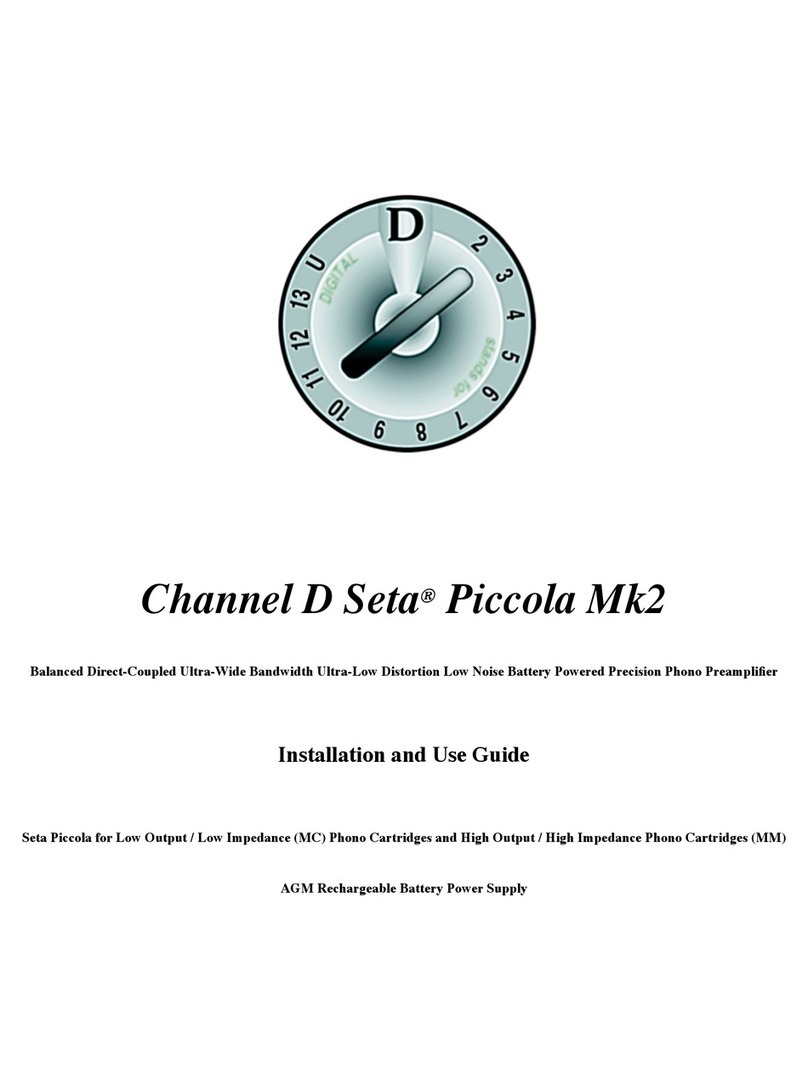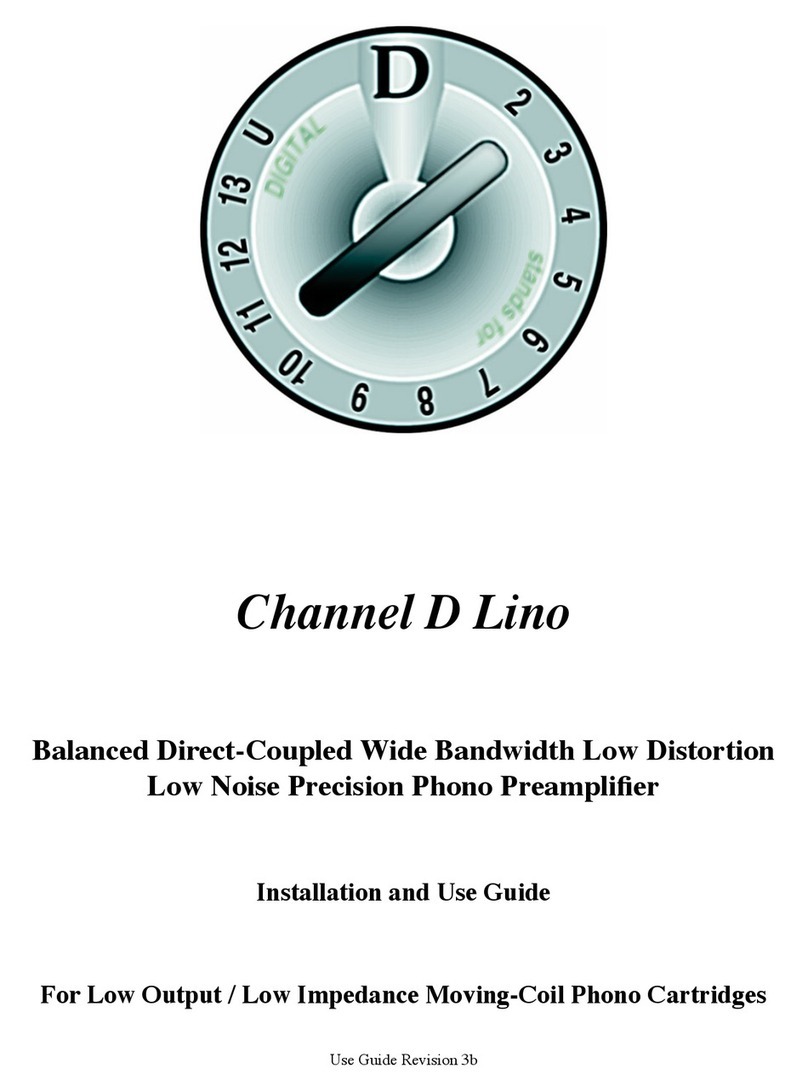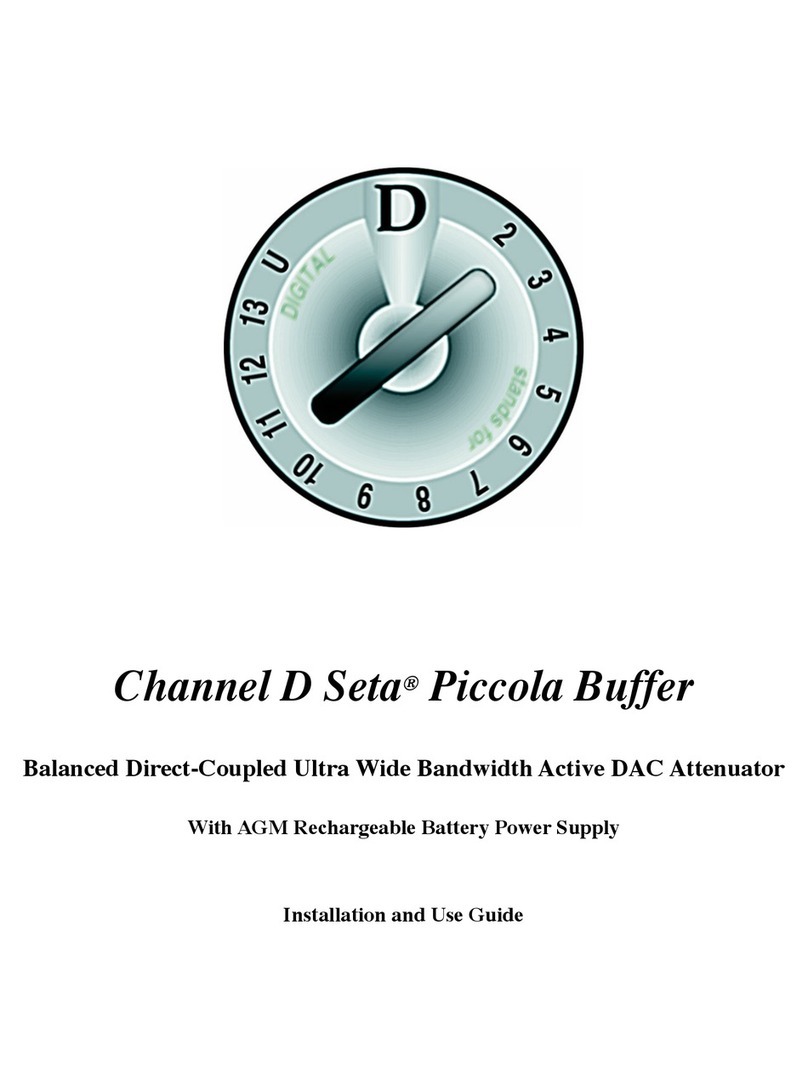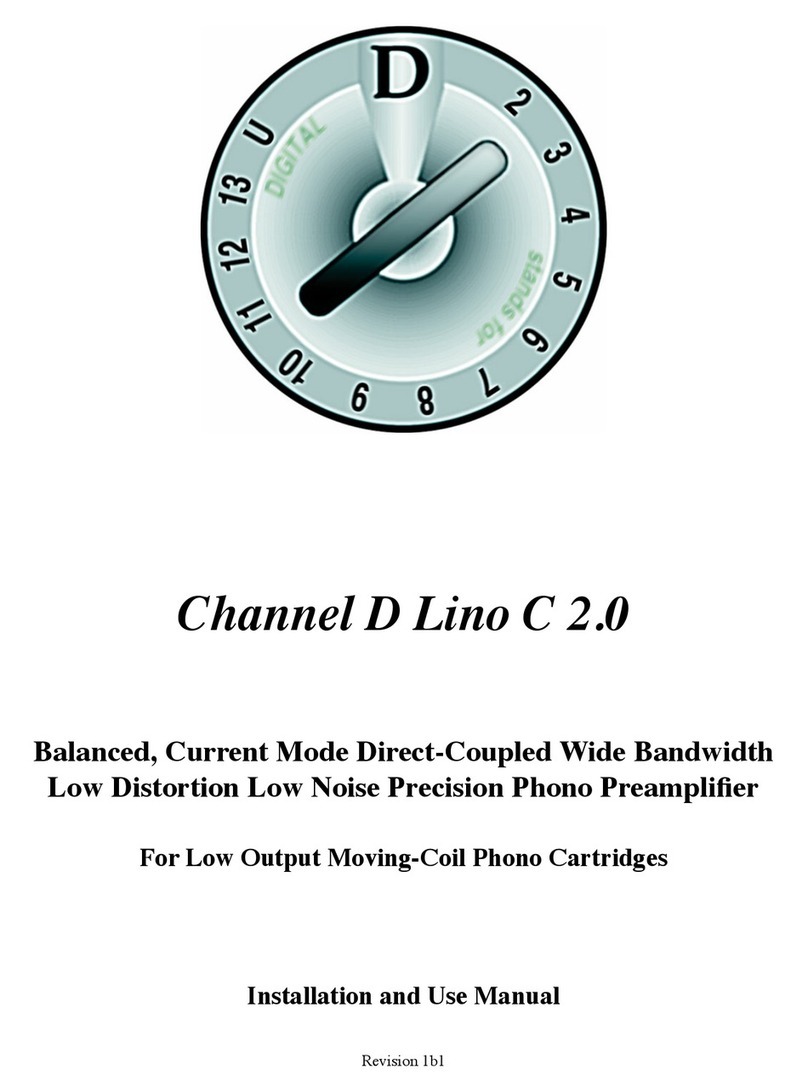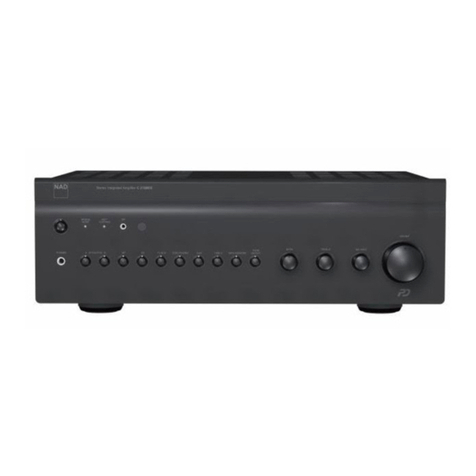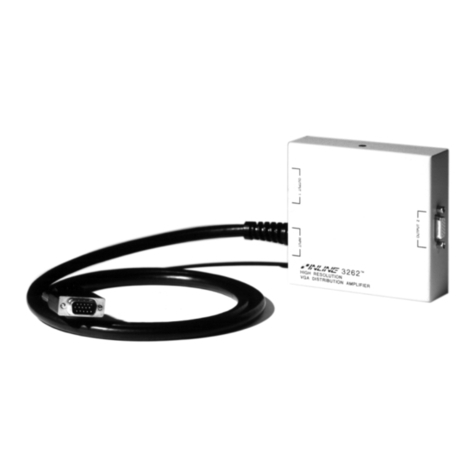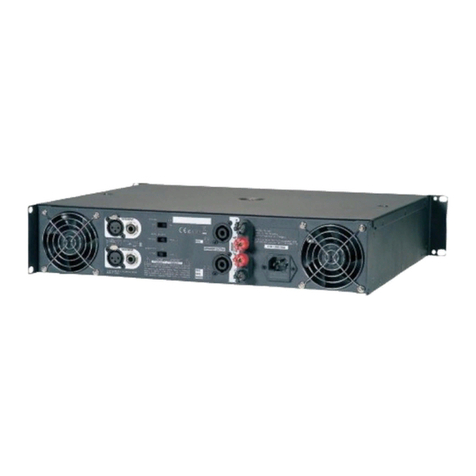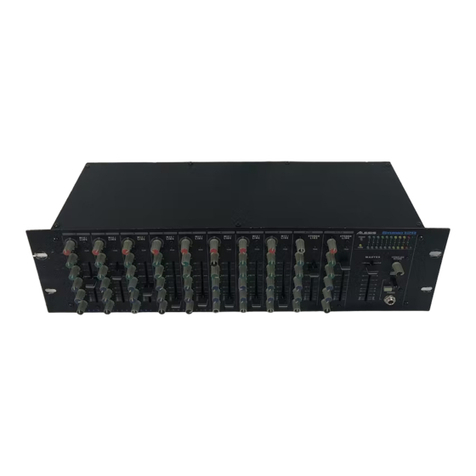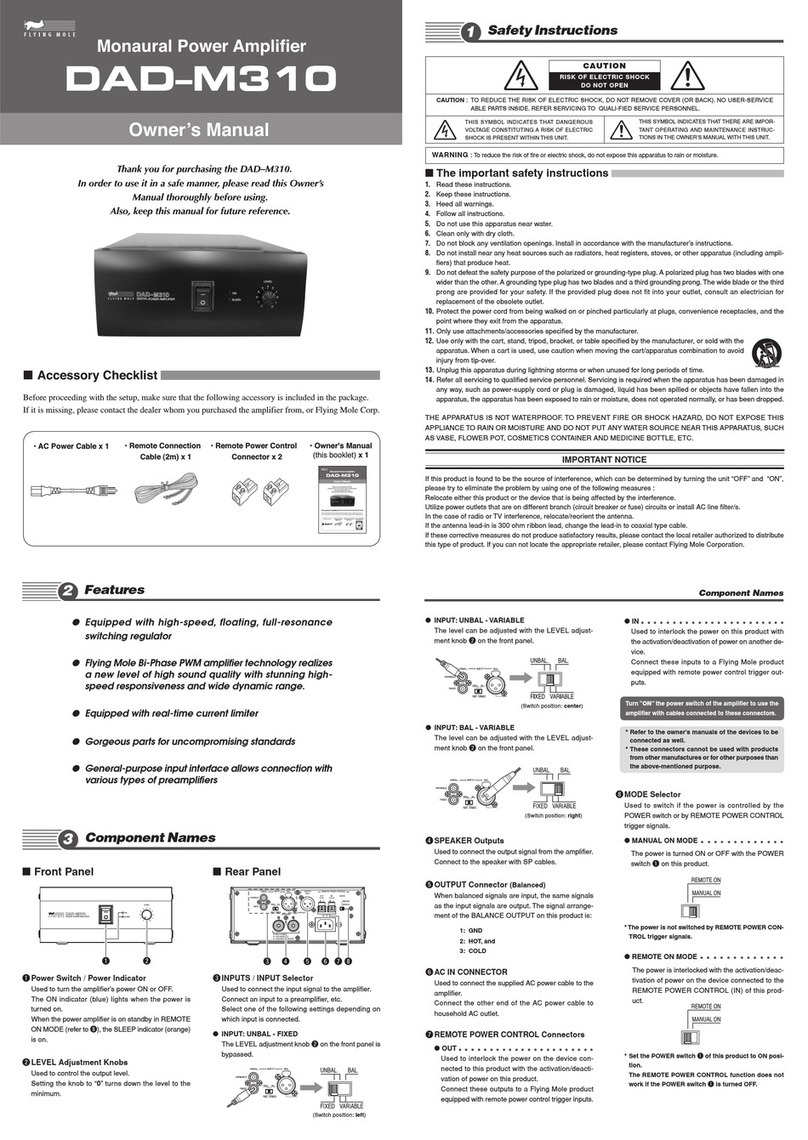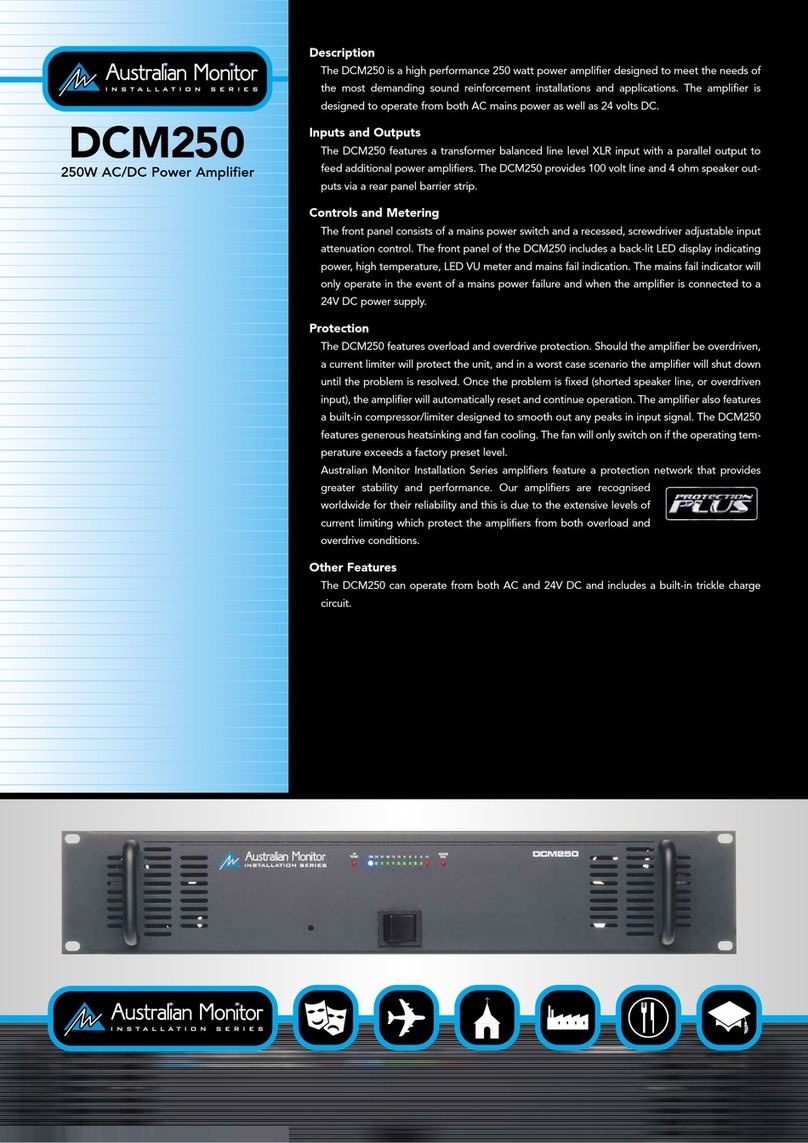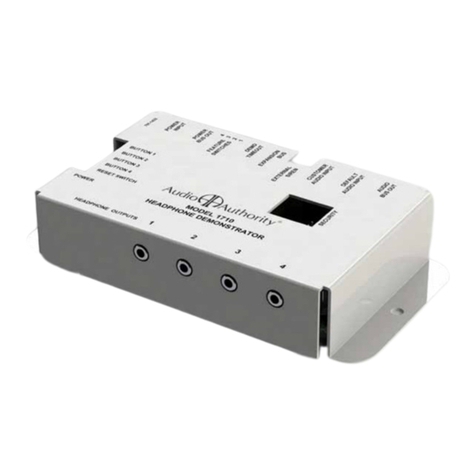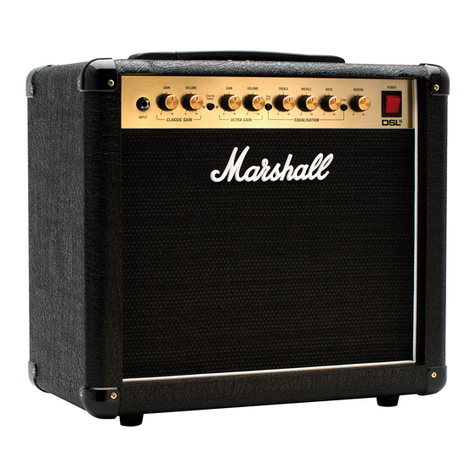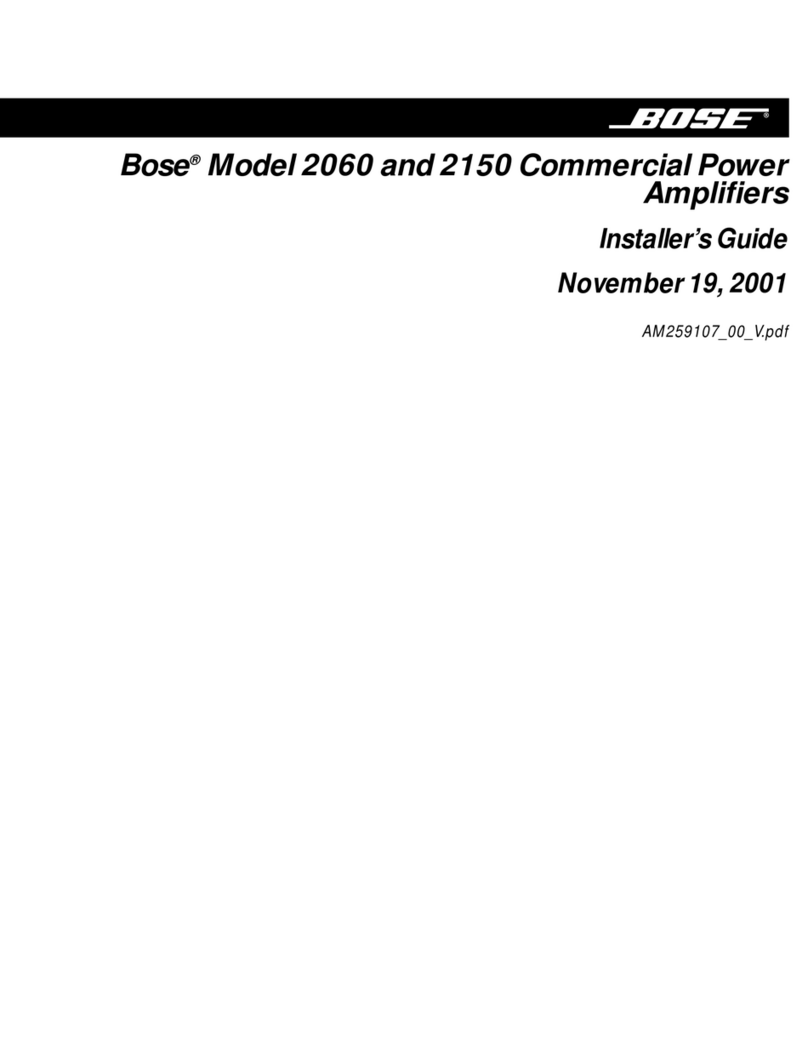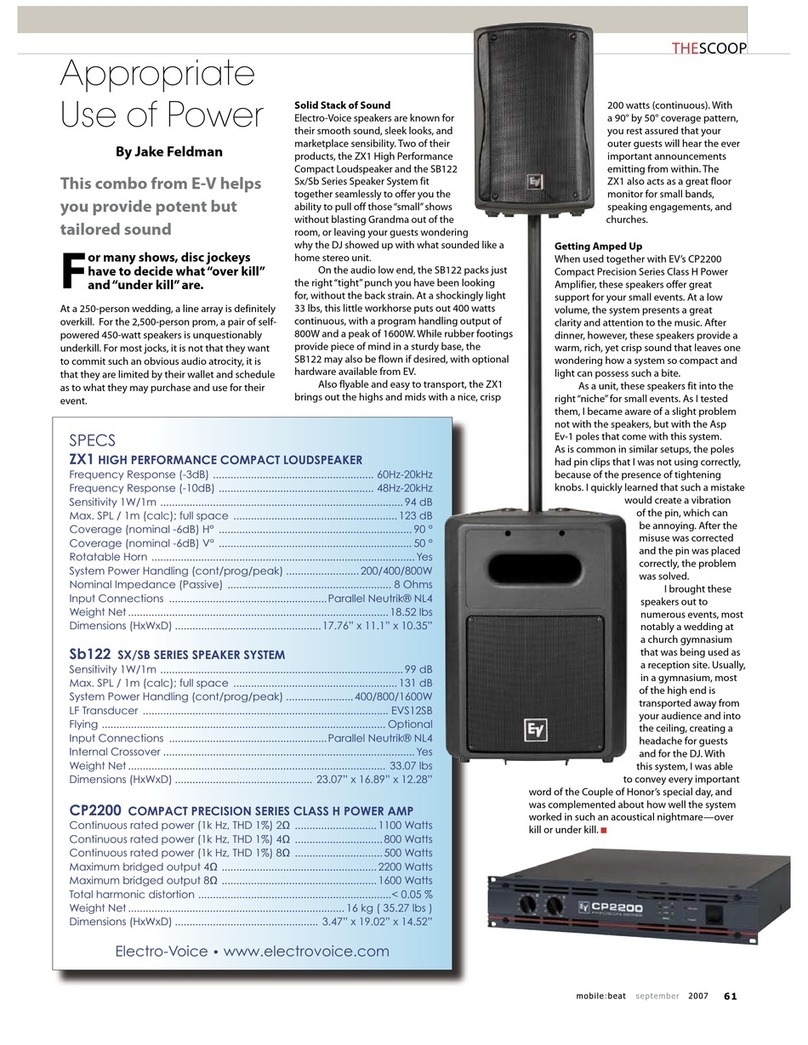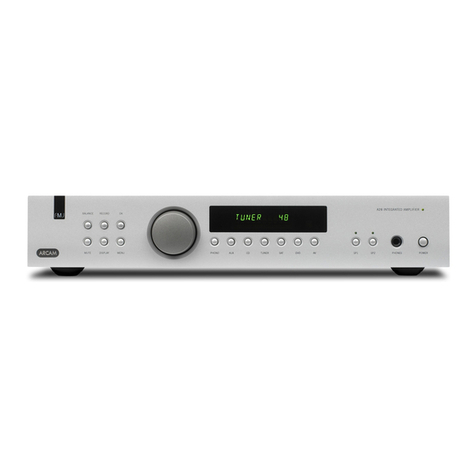Channel D Lino C 3.0 Guide

Channel D Lino C 3.0
Balanced Transimpedance Direct-Coupled Wide Bandwidth
Low Distortion Low Noise Precision Phono Preamplifier
For Low Output Moving-Coil Phono Cartridges
Optional Moving-Magnet and Voltage-Mode MC Inputs
Installation and Use Manual

QUICK START
1. Allow your Lino C to fully acclimate to ambient temperature
for a few hours before removing it from the inner plastic bag.
2. Current mode phono preamplifiers use balanced input wiring.
Balanced wiring consists of a twisted pair of two independent
conductors inside a shield, for a total of three independent
conductors. Current mode phono preamps may exhibit audible
hum with unbalanced (coaxial conductor with shield) wiring.
RCA to XLR adapters* may be usable, but a properly wired*
balanced interconnect is needed to guarantee no audible hum.
*XLR pin 1 must be connected only to the cable shield; for adapters, pin 1 left open / not connected
3. Unmodified Rega turntables and tonearms cannot be connect-
ed to balanced preamplifiers because Rega connects the chassis
ground to a cartridge signal connection, preventing making a
balanced signal connection, resulting in noise and hum.
4. Connect the turntable and output connections. Connect the
power adapter to your Lino C. The barrel connector of the
power adapter will easily slide into the power input jack on the
rear of your Lino C. If it seems to not slide in easily, verify the
alignment of the plug and try again. It can be damaged by using
excessive force. Next, plug the line cord into utility power.
5. A blue indicator on the bottom of the chassis will illuminate
when the circuitry is powered.
6. Keep your Lino C continuously connected to utility power for
optimum battery life; the internal Class A biasing circuitry also
takes approximately 30 minutes to fully stabilize after a power
down.
7. Disconnect the power adapter from the rear of the Lino C to
fully power down the Lino C.


Channel D Lino C 3.0 Installation and Use Manual
3C77;%
www.channel-d.com
1TSSX1TUWNLMa%+%%1MFSSQ2/QQNLMXXWI

Table of Contents
Page
Getting Started 2
Signal Connections 3
Optional Moving Magnet Input 4
Optional Voltage-Mode Moving Coil Input 5
Power Up 6
Power Down 6
About the Lino C Rechargeable Battery Power Supply 6
“Off the Grid” (OTG) Mode 7
Lino C Configuration Bottom Chassis Cover) Gain / Damping 8
Battery Power Supply Auxiliary Settings 10
Optional signal conditioning settings and inputs:
16 Hz High Pass Filter, MONO, POLARITY 11
Charging / “On Grid” Signal Port 12
AGM Rechargeable Battery 13
Opening the Lino C Chassis / Removing the Lid 16
Specifications 18
APPENDICES
Sample RIAA Accuracy Graph 19
Troubleshooting 20
Lino C Galvanic Isolation Block Diagram 23
Battery Circuit Board Description 24
Using an IoT Relay for Automation of Off The Grid Mode 26

Page 1
Congratulations on purchasing a Lino C phono preamplifier! Your Lino C is a low noise, low
distortion, balanced transimpedance (current mode) design featuring a wide frequency bandwidth and
extremely accurate RIAA de-emphasis. This provides you with the key to obtaining stunning and lifelike,
three-dimensional music reproduction from your LP records.
Your Lino C is specifically designed to deliver extremely high quality music reproduction from low
output moving-coil cartridges (and moving magnet cartridges, with the optional MM input).
Lino C incorporates newly available power supply components that enable circuit design strategies
delivering power supply performance very closely approaching that of our flagship Seta® rechargeable-
battery phono preamplifiers. Like our flagship Seta models, modern manufacturing methods are used,
including low-noise, four-layer circuit boards and precision, surface mount components. Surface mount
components provide the shortest signal paths and highly optimized circuit layouts, with low stray
inductance, capacitance, improved unit to unit consistency and performance all eclipsing old-fashioned
through-hole designs. The result is a phono preamplifier with exquisite performance far exceeding
expectations, especially considering its relatively modest price in the arena of most high end components.
The high precision (guaranteed better than ± 0.1 dB) RIAA EQ accuracy provides standard RIAA-
corrected phono preamplifier outputs with outstanding quality.
The low impedance AGM battery based power supply with proprietary Channel D - developed charging,
maintenance and galvanic isolation circuitry provides outstanding “off the grid” isolation from power
supply related noise and interference issues that preamplifiers with conventional power supplies must
contend with.
Lino C also is perfect as a preamplifier for connecting to high resolution (192 kHz / 24 bit), balanced-
input analog to digital converters (ADCs). The Lino C’s selectable Flat output used in conjunction with
Channel D’s Pure Vinyl™ software providing RIAA EQ correction combines the strengths of the latest
cutting-edge analog and digital technologies, delivering superb, high definition transparent vinyl
playback.
The benefit of having the availability of selectable Flat and RIAA outputs can facilitate linking analog LP
playback with the performance and flexibility of high resolution digital audio, should you desire to do so
later in the future.

Page 2
Getting Started
Please take the time to read this Installation and Use Manual to familiarize yourself with the installation
and operation of your Lino C.
Important: If the package you received from your shipper is substantially above or below ambient
temperature, please allow your Lino C to acclimate at room temperature for a few hours before opening
the plastic bag containing your Lino C, to avoid causing condensation on cold internal surfaces (if colder
than ambient temperature), and to allow the internal battery to come to temperature equilibrium for
optimal operation.
The following items are included. Please check the package and notify Channel D of any discrepancy:
g 9NST1WFRUQNKNW
g 3WSFQ(TQUTWXUUQ%RRNUUTXNNT%%CTQ()67SUBITRXNHTHTSIHTW
UTWHTWIHFSGXINMNSWSFNTSFQFIFUWX
g %d/QQS8
g ;TSHTSIHNXQXKTWXNSLHTSKNLWFNTSXNHMX
g /HHXXTWNSWQTHPKTWSFGQNSLKKAM5WNIRTI
g /HHXXTWWNLMFSLQ%(RRGFWWQUQLNMXWNUUIFSINSSIUNLFNQKTWTUNTSFQ/TRFNHKKAM5WNI:TI
g QLHTWXKTWGTTRXNHMFHHXXUTWX
g WKTWRFSH:FXWRS5WFUMXMTNSLTWTS9NST1bXRFXWI7//3FHHWFHAMXWNFQSRGWTKM
7//HNWHNGTFWINSXNITW9NST1NXMXFRFXMXWNFQSRGWTKTW9NST1
Before making any input signal connections, disconnect the power supply from the rear of the Lino C.
If using Channel D Pure Vinyl™ software: be sure to mute the Pure Vinyl application software, if running on the
computer, or otherwise mute or power down your power amplifier(s) while making signal connections, to avoid
generating noises which could damage loudspeakers.
Lino C 3.0 rear panel shown above with optional Moving Magnet and Voltage Mode Moving Coil Inputs
MC Transimpedance Input (also applies to optional Voltage Mode input)
•The Lino C MC transimpedance input requires balanced (shielded twisted pair, which is two
conductors inside a shield for a total of three independent conductors; as contrasted with coaxial
unbalanced cable which is one conductor plus a shield) connections to the turntable. Turntables
with RCA jacks can be used with an RCA to XLR cable.
Important: Pin 1 of the XLR connector must not be connected to either of the signal
conductors, or hum/noise/distortion will result. Pin 1 should only be connected to the cable
shield. If you detect any hum/noise/distortion please detach and check your input connection
cable using a continuity tester or ohmmeter to insure that Pin 1 of the XLR is not internally
connected to Pins 2 or 3.
Balanced cable and signal connections provide better noise immunity (because of common mode
noise rejection) than conventional shielded (single conductor plus coaxial shield) cable. They are
also a requirement for a current mode preamplifier, or hum/noise/distortion will result.

Page 3
Standard Transimpedance Input (and Shared Outputs for Optional Inputs)
Signal Ground
•Securely connect the ground wire from the turntable / tonearm (if so equipped) to the binding post
on the rear panel of the Lino C. This terminal is connected to circuit common. It is not connected
to the chassis, which is floating in a Faraday cage configuration. If your turntable doesn’t have a
grounding connection, leave this terminal disconnected. Important: only connect the ground to a
turntable chassis or ground wire, not to a ground connection on any other equipment.
Chassis Ground
•The Chassis Ground is not normally used, however it is provided in response to requests to
facilitate connecting the common terminal of a third-party power conditioner.
Balanced Outputs
•The low impedance, balanced XLR outputs are configured by the factory to supply conventional
RIAA corrected output.
The balanced outputs also can be configured to bypass the RIAA EQ for connection to the
balanced inputs of a professional audio interface, for use with Channel D’s Pure Vinyl™ software
(for Mac computers) for applying RIAA compensation. (Consult the Pure Vinyl software User
Guide for more information.)
If necessary, XLR output pin 3 may safely be connected to circuit common / ground (Pin 1),
because the Lino C has servo balanced (ground sensing) outputs.
Single-Ended Outputs
•The single-ended / unbalanced outputs supply conventional RIAA corrected output for use with
single ended / unbalanced outputs for a line preamplifier lacking balanced inputs. This corresponds
to a standard phono preamplifier (with RIAA EQ curve) output signal.
The RCA phono outputs are true, single ended (unbalanced) connections derived by differentially
summing the balanced signal “legs,” rather than taking the unadvisable shortcut of only using the
positive polarity signal leg of the balanced circuit, which would deliver poor performance.
Also, the standard RIAA EQ compensated signal appearing on the RCA output connectors is
generated from a signal side chain independent of the XLR / balanced outputs, and may be used
simultaneously with the XLR outputs without compromising the performance of the Lino.
Note: the Balanced and Single-Ended outputs are on separate signal chains, and may be used simultaneously.

Page 4
Optional Moving Magnet Input
Signal Inputs
•The Moving Magnet inputs are balanced, but use RCA input connectors. Input cables can be
standard unbalanced coaxial cables, or balanced, shielded twisted pair. If using shielded twisted
pair balanced cable, note that the capacitance can be 40 - 50 pF per foot, and this would need to be
added to the capacitive load switch settings.
To configure the input for Unbalanced, set the UNBAL switch setting for each channel to on.
Cartridge Loading
•Adjust capacitive loading with the switches. Intermediate settings are available by combining the
settings. The capacitances are additive. For example, selecting the 100 and 47 pF settings the
resulting capacitance is 147 pF.
With all capacitive loading settings disabled, the background capacitance is approximately 5 pF.
The minimum capacitive switch setting is 33 pF.
The fixed load resistance is 47000 ohms.
Signal Ground
•Connect the ground wire from your turntable / tonearm (if so equipped) to the grounding lug. This
terminal is connected to circuit common. A removable banana plug is provided, with a set screw
for securing a ground lead terminated in a spade lug, otherwise a bare wire can be twisted around
the set screw and the screw tightened.
If your turntable doesn’t have a grounding connection, leave this terminal disconnected.
Important: only connect the ground to a turntable chassis or ground wire, not to a ground
connection on any other equipment.
Gain
•The input gain is 36 dB and can be increased via the Gain adjustment switches: 39 dB (+3), 42 dB
(+6) or 45 dB (+3 and +6) dB.

Page 5
Optional Voltage - Mode Moving Coil Input
Signal Inputs
•The Lino C second MC inputs are balanced, requiring balanced cables for optimal performance.
An internal jumper setting is provided to configure the input for Unbalanced operation; however
even when using a coaxial input cable, better results are usually obtained by keeping the input
configured for Balanced operation.
Cartridge Loading
•Adjust resistive loading with the switches. Intermediate settings are available by combining the
settings. Resistances combine geometrically. For example, selecting the 100 and 200 ohm settings,
the resulting resistance is 1 / ((1/100) + (1/200)) = 67 ohms. If selecting more switches, the same
principle follows. For example, selecting the 200, 500 and 750 ohm settings, the resulting
resistance is 1 / ((1/200) + (1/500) + (1/750)) = 120 ohms.
With all resistive loading settings disabled, the resistance is 1000 ohms.
Signal Ground
•Connect the ground wire from your turntable / tonearm (if so equipped) to the grounding lug. This
terminal is connected to circuit common. A removable banana plug is provided, with a set screw
for securing a ground lead terminated in a spade lug, otherwise a bare wire can be twisted around
the set screw and the screw tightened.
If your turntable doesn’t have a grounding connection, leave this terminal disconnected.
Important: only connect the ground to a turntable chassis or ground wire, not to a ground
connection on any other equipment.
Gain
•The input gain is 58 dB and can be increased via the Gain adjustment switches: 61 dB (+3), 64 dB
(+6) or 67 dB (+3 and +6) dB.

Page 6
Power Up
•Connect the 5 volt power adapter to the power input jack on the back of the Lino C, and then
connect the line to utility power. The Lino will activate after several seconds. A faint click may be
heard as the internal relays are engaged.
Insert the barrel connector into the rear panel receptacle with gentle, minimal force. If it seems to
not insert into the receptacle, please insure it is correctly aligned with the connector. Do not apply
excessive force or the receptacle may be damaged. Two green power indicators will illuminate on
the bottom of the chassis.
Power Down
•Any operating scenario: Unplug the 5 volt power adapter from the power input jack on the back of
the Lino C.
•Off The Grid Mode not enabled (this is the default factory supplied mode): Unplug the 5 volt
power adapter from the AC utility line.
•Off The Grid Mode enabled (by using the supplied interlock or pigtail accessory cord): Use the
STANDBY button under the front panel. Important: if using an IoT Relay to automate Off The
Grid Mode (see Appendix), you must also power down the relay using its power switch (or unplug
it from the AC utility line), or your Lino C will not power down completely.
Please refer to the Off The Grid Mode section of the manual for additional information.
About the Lino C Rechargeable Battery Power Supply
•Keep the Lino C continuously connected to utility power for maximum battery life. The
resulting quiescent power draw is low, less than 2 watts (and a fraction of that if placed in Standby
mode). Battery charging is automatically managed. The charging adapter is disconnected
internally when an input signal is detected. Then, the Lino C is galvanically isolated. The
charging adapter will be automatically reconnected, recharging the battery, when an input signal is
absent for approximately 10 minutes.
To prolong runtime indefinitely, engage CHARGE LOCK mode by pressing the right switch under
the left side of the chassis.
If you wish to minimize idle power consumption while keeping the battery fully charged, engage
STANDBY mode by pressing the middle switch under the left side of the chassis. This will power
down the amplifier circuitry except for the battery charging and maintenance circuitry. Important:
reduce the playback volume or power down the rest of your audio system before engaging or
disengaging STANDBY mode to avoid any transient noises.
•The 9 ampere hour AGM battery will provide over 16 hours of continuous operation. Having the
battery sited inside the chassis with the circuitry insures that it serves as a noise sink instead of
antenna, if it were housed externally and connected via an umbilical. The benefits of its low
impedance are also realized because the battery is physically close to the circuitry being powered.
Important note: Do not replace the power supply with a different one. The two-wire power
supply has been very carefully selected for galvanic isolation and low noise. If replaced with
a linear supply or a three-wire supply even of exactly the same rating, the internal circuitry
may be damaged. This will void the warranty.

Page 7
In answer to user inquiries: the performance of the Lino C will not be improved by substituting a battery
for the power adapter. The Lino C depends on having a relatively stable 5 volt (within ± 0.2 volt) DC
input. This is not possible to achieve with any type of battery chemistry without also providing additional
voltage regulation. An input supply voltage above 5.2 volts will damage the Lino C. An input voltage
below 4.8 volts will result in diminished performance and battery life, and the Lino C may not even
operate.
Power Adapter: The external, brick style supply adapter provides a galvanically isolated (a key
consideration) raw DC voltage. The output is not used "straight" from the adapter, but stepped up
inside the preamplifier to split supplies and then very highly filtered in multiple stages.
The circuitry employs a 4 layer circuit board with separate and continuous low inductance, low
impedance internal ground and power planes congruent with the preamplifier circuitry. The
resulting power supply rails have much lower noise and ripple and tighter regulation than a
linear DC supply can provide. This is borne out in the signal to noise performance. A welcome
additional benefit is very low idle power consumption and negligible heat production.
This kind of design wasn't even possible as recently as just 10 years ago. However, we now have
a plentiful palette of new components to pick and choose from, thanks to the burgeoning
consumer electronics industry's continuing quest for increasing miniaturization and reduced
power consumption.
Off The Grid (OTG) Mode
Your Lino C may be operated entirely from the internal battery by disconnecting the wall plug
from utility power and keeping the barrel connector inserted in the back of the Lino C. This can be
confirmed by the power indicator on the bottom of the chassis, and of course, the Lino C’s
operation.
OTG mode is only enabled by inserting the supplied interlock or the included accessory 2-
conductor pigtail signal cord into the port on the underside of your Lino C.
Reconnect the Lino and power adapter to utility power after using this mode to maintain the
battery charge and to insure optimum battery life.
OTG Mode with automatic battery charging may be obtained by using an optional IoT relay.
Please see the Appendix for more information.

Page 8
Lino C Configuration - Bottom of Chassis
The internal signal routing of the Lino C is configurable. The factory “out of the box” settings are
preconfigured for the most common usage scenario, or can be changed to suit your preferences.
Unplug the power supply from the jack on the back of the Lino C before changing the
GAIN, DAMPING or BALANCED OUT settings.
Use the supplied nonconductive stylus to actuate the configuration switches. A fine tipped screwdriver
also may be used, very carefully.
When making configuration settings, place the Lino on a flat surface covered by a soft cloth to avoid
marring the finish.
(1) Preamplifier Gain, primary transimpedance input: The gain is adjustable via two four-pole DIP
switches. There are 0 dB and +6 dB settings, plus maximum (+12 dB) gain by placing both of the two
four-pole switches in the right-most position. The factory setting is for minimum gain (0 dB). For
maximum signal headroom, only select a higher gain setting if required for matching the level to
other components in your system. The gain settings are not cumulative; that is, the only settings are 0
dB, 6 dB and 12 dB.
Information for Pure Vinyl™ users: The Pure Vinyl User Guide includes complete information on setting the
proper preamplifier gain for transferring LPs to digital files (with an external ADC - not included). Briefly, you
should aim for “Dry” signal level peaks in Pure Vinyl between -12 and -2 dBFS, for the music that you usually
play. Provided that peaks usually reach these levels, it’s not necessary to have to adjust the gain setting frequently, or
at all. It’s prudent to allow at least 4 to 6 dB of headroom below full scale, to accommodate unexpectedly loud
modulation levels. At the low end of the suggested signal range above, be certain that a signal peak represents music
and not “pops” or “clicks.”
If your audio interface permits setting nominal input signal levels to consumer or professional format (true of
professional audio interfaces from Lynx, RME, etc.),first try the consumer (“-10 dbV”) setting, in conjunction
with the minimum gain setting on the Lino.
•If signal levels are too high, set the input of the audio interface to professional (“+4 dBu”) format.

Page 9
•If the levels are too low, increase the gain on the Lino C. (For monitoring / playback, if the output levels of your
interface can be adjusted independently of the input levels, use the +4 dBu setting for the output.)
(2) Balanced Output Signal Connectors (BAL OUT)
Balanced Output Phono Stage (factory setting): slide the two DIP switches to the RIAA
position. The factory configuration is for the standard RIAA output setting.
Flat Phono Preamplifier for using with an external ADC and Pure Vinyl: slide the two DIP
switches to the FLAT position.
Do not set the switches to any other setting than shown, or severe distortion will result.
(3) Cartridge Loading: As a current mode phono preamplifier, the Lino C doesn’t require setting the
cartridge load. All of the signal current produced by the cartridge is fully used with this design, which also
insures that the cartridge’s mechanical and electrical characteristics are fully damped and optimized.
(4) Cartridge Damping Setting: Low output moving-coil cartridges that have an internal impedance of
about 12 ohms or more may perform more optimally by setting the Damping switches on the underside of
the Lino C to the HIGH Z (high impedance) position.
All Damping switches must be set identically.
The factory setting of the Damping control is LOW Z (low impedance). This is optimal for low output,
low impedance moving coil cartridges. However, it may be worthwhile to experiment with this setting.
Some users who purchased Lino C version 2.2 preamplifiers that had incorporated this circuitry into the
newest production units reported sound quality benefitted even with their low impedance cartridges.
(5) POWER indicator: Illuminates Blue when the circuitry is powered up.
(6) SIGNAL indicator: Illuminates Green when an input signal is detected.

Page 10
Bottom of Chassis: Battery Power Supply Auxiliary Settings / Optional Signal Modifier and Input Selector Switches
(viewing bottom bottom front edge with Lino C upside-down)
Front Panel (with Optional Engraved Labelling and LED Indicators)
(7) Optional signal conditioning and additional inputs: Input selector and signal modifier settings are
activated via silky smooth positive-action soft blue LED illuminated switches mounted underneath and
along the front edge of the chassis, flush with the bottom of the bottom panel. The power supply auxiliary
settings are operated by non-illuminated switches with a different tactile feel.
Mirror style labels are provided underneath along the front edge so that the switch labels can be viewed
with a small mirror. A mnemonic card also is provided showing the switch locations.
Front panel function labelling and LED indicators are available as an option. LEDs are illuminated Blue
with the function active and Green with the function off. The front panel LED indicators automatically
adjust brightness in response to ambient light levels, becoming quite dim in a darkened room. The
standard Lino C 3.0 is supplied without the indicators and engraved labels for those who prefer an
uncluttered front panel.
Battery Power Supply Auxiliary Settings
• STANDBY: Minimizes idle power consumption while keeping the battery fully charged. This
will power down the amplifier circuitry except for the battery charging and maintenance circuitry.
In OTG Mode, operating the STANDBY switch will completely power down the Lino C.
Otherwise, this would require unplugging the power adapter from the back of the Lino C to
power down. See Off The Grid Mode for more information.
Important: reduce the playback volume or power down the rest of your audio system before
engaging or disengaging STANDBY mode to avoid any transient noises.
• CHARGE LOCK: Prevents the battery charging circuit and power adapter from being
disconnected. The battery will be kept fully charged.
Use this setting if you wish to operate your Lino C for extended periods of time, such as for
component break-in. It also is used if the battery becomes depleted during a listening session, to
keep the charging circuit from cycling on and off.

Page 11
Measured Frequency Response (4 Hz to 4 kHz frequency range shown) of Optional 16 Hz 18 dB / Octave
High Pass (Rumble) Filter
Optional Signal Modifier and Input Selector Switches
• 16 Hz HPF: Activates the 16 Hz 18 dB / Octave high pass (rumble) filter. Use with warped
records to preserve signal headroom and avoid low frequency woofer excursions.
• MONO: Sums the signal from both input channels and outputs the same signal to the Right and
Left channel outputs.
• POLARITY: Inverts the absolute signal polarity.
• MM IN (IN 2): Activates the optional Moving Magnet input. If your Lino C is supplied with
only an optional second MC input, this will be labelled MC IN.
• MM/MC2: In a Lino C equipped with optional MM and second MC inputs, selects between
MM and MC2 inputs:
• To use the MM input, activate MM IN and deactivate MM/MC2.
• To use the second MC input (MC2), activate both MM IN and MM/MC2.

Page 12
(8) Charging / On Grid Signal Port: A 2.5 mm barrel type connector jack is provided on the bottom of
the preamplifier. When the Lino C is playing music (signal present) the jack (tip contact) will have 5
volts. When the Lino C is in charging mode (or powered down), 0 volts is supplied at the jack tip contact.
The 0 volts is referenced to chassis ground (circuit common), which is connected to the “barrel” contact
of the jack.
This can be used in conjunction with the Lino C’s “Off The Grid” (OTG) mode.
The charging supply is automatically disconnected internally when a signal is present. However, some
audio enthusiasts express concern about external power supplies affecting the quality of the utility line
power delivered to other components in the audio system. OTG mode addresses this concern by allowing
the Lino C to operate for 16 hours without having the charging supply connected to AC utility power.
The “OTG Mode Enable Interlock”
OTG Mode requires that the supplied barrel-type Interlock plug be inserted into the Charging
signaling port on the underside of the Lino C (or the pigtail extension wire and plug for the
signaling port).
Without either of these inserted in the Charging signaling port, the Lino C will power down when
utility power is removed, whether or not the power adapter plug is connected to the rear of the
Lino C.
This insures that one must deliberately “opt in” to enabling / using OTG Mode, including the
possibility of fully discharging the battery if the utility power is not reconnected.
• MANUAL OTG Mode: Disconnect the power supply two prong plug from the AC utility power line
(or unplug the “figure 8” cord from the power supply). The power supply barrel must remain inserted in
the Lino. Unplugging the barrel connector will power down the Lino.
When finished listening, be sure to remember to reconnect the power supply to the AC
utility line to recharge the battery / prevent it from becoming discharged.
• AUTOMATIC OTG Mode: An optional, isolated power switching relay is required (not supplied).
These can be obtained from vendors like Amazon. Example:
https://www.amazon.com/Iot-Relay-Enclosed-High-Power-Raspberry/dp/B00WV7GMA2
or search Amazon for “AC / DC Control Relay” or search the Internet for “IoT Relay”
These relays use a trigger input, such as the 5 volt signal supplied on the Charging / On Grid
Signal Port to activate the power line.
The charging signal port can be used to automatically connect and disconnect the Lino C power
supply from the utility power. When a signal is present and the preamplifier is in operation, the
power supply is completely disconnected from the AC utility line. When a signal is not present,
after a delay of several minutes the power supply is automatically reconnected, charging the
battery.
Please see the Appendix of this manual for more information about using the external IoT relay.

Page 13
About the AGM Rechargeable Battery
The AGM type lead/acid rechargeable (“secondary”) battery is superior to all other battery types for high-
end audio.
Li-Ion: Audio doesn’t require the lower mass of lithium-ion needed in automotive or “drone” aircraft
applications. The charging electronics of Li-ion are troublesome, and such batteries can fail in spectacular
and hazardous ways.
Primary (non rechargeable) Li or any other disposable battery are inconvenient for use in a stationary
product (and also see below comments regarding primary alkaline batteries).
NiCd / NIMH: Has low impedance but the disadvantage of low (1.2 volt) cell voltage, necessitating
connecting nearly double the number of cells in series for the same operating voltage. Large-capacity
sizes are difficult to obtain and very expensive, and recycling is cumbersome for small-volume end-users
(who may be tempted to dispose of expired batteries in unsafe or environmentally unsound ways).
AGM will not leak electrolyte if the case is damaged/cracked because the electrolyte is contained by the
sponge-like fiberglass battery plate separators. The battery may be operated in any position, even upside
down (terminals facing downwards). AGM is also about one-fifth the cost of a Li-ion battery with the
same energy storage capacity.
“Primary” (throw-away or non-rechargeable) batteries such as 1.5 or 9 volt alkaline cells are totally
unsuitable for high quality audio applications because of their very high internal impedance and
susceptibility to electromagnetic noise pickup.
The AGM battery is capable of supplying over 50 amperes of peak current. The battery is conditioned and
kept float-charged by a proprietary circuit developed by Channel D, rather than use an "off the shelf"
microprocessor based conditioning and monitoring circuit (which is necessary for Li-ion), which would
introduce unwanted noise. Locating the battery inside the preamplifier chassis also insures that the battery
is in the same electrical environment as the sensitive circuitry, eliminating many sources of noise pickup.
Though AGM contains lead, the recycling of lead batteries and complete recovery of lead as a valuable
commodity is routine practice nowadays. Accordingly lead batteries have minimal environmental impact.
Rechargeable AGM Battery Operational Considerations: The Lino C should always be kept powered,
to maintain a stable circuit temperature and the condition of the AGM battery. The power consumption
(no signal) when the battery is fully charged is low, less than 2 watts. If necessary, the Lino C may be
disconnected from the power supply for several months without adversely affecting the battery life. Do
not store the Lino C at elevated temperatures, such as in an attic or garage.
The Lino C must be connected to the external power supply to initially power up. This design insures that
the battery isn’t accidentally over-discharged, which could shorten its life. The power supply is used to
activate two normally-open relays, which connect the battery to the Lino C circuitry, and the charging
supply to the battery (see Appendix for a simplified diagram of the galvanic isolation circuitry). When a
signal is detected (also true of the power-up state), the second relay is deactivated, disconnecting the
charging supply from the battery (and the Lino C preamplifier circuitry). The battery voltage monitoring
and power management are automatic. A new battery, when fully charged, is capable of supplying power
for 16 hours of continuous operation.

Page 14
The Lino C will automatically activate Charge mode (with the power adapter connected and connected to
utility power) under either of the following two normal conditions:
•A signal resulting in an output level of less than -20 dBV isn’t detected for about 10 minutes.
•The AGM battery has exhausted its charge.
Battery Life / Battery Replacement
Typical battery life will be between 3 and 5 years; up to 20 years is possible. The battery life is deter-
mined by three factors:
(1) operating environment ambient temperature. Temperatures at or above 80 F should be avoided,
as this will shorten the battery life
(2) the number of deep discharges, defined as continuous operation with a signal connected (or in
100% battery mode) for more than 16 hours, or until the battery switches to charging mode
(3) battery life will be extended by keeping the Lino C continuously connected to a power source
and the battery fully charged. The idle power consumption is less than 2 watts.
Battery capacity also typically will increase slightly (by a few percent) during the first few discharge /
recharge cycles.
Testing Battery Capacity: This test only would be performed annually, if at all, and unnecessary on a
new Lino C which will always have a new and fully tested battery installed.
If not operating the Lino C in OTG Mode, insert the supplied Interlock in the socket in the port on the
underside of the chassis. Disconnect the power adapter from the wall socket. If the Lino C shuts off in
less than six hours, the internal rechargeable battery should be replaced. In general, it is unnecessary to
have to test the battery capacity.
The battery is a widely available and economical type, commonly used for security alarm systems or
remote power backup. They can be obtained from online retailers such as Amazon (search for Power
Sonic PS-490; we recommend only using the genuine gray and blue Power Sonic brand rather than a
putative “replacement” type). Alternatively, McMaster-Carr (mcmaster.com) part number 7448K25 is the
Power Sonic PS-490. Overseas, Power Sonic has distributors and dealers on every continent.
•It’s best to obtain a “fresh” replacement when needed, rather than keeping spares on hand, because
degradation will begin to occur if stored for more than a few months without charging. The Lino C
may be operated continuously, even with a degraded battery, so waiting for replacements to ship
shouldn’t be a problem.
•The replacement battery should be at ambient room temperature before installing.
If you don’t wish to perform the battery replacement yourself, the Lino C can be shipped to Channel D for
battery replacement. Please contact Channel D for shipping information and pricing, and a Return
Material Authorization number.

Page 15
End-User Battery Replacement Instructions
Important Safety Notice: when replacing batteries, hazardous voltages aren’t present, but the
battery is capable of supplying large currents (similar to an electric arc welder).
This high current capability is important to the superior audio performance of the Lino C, but
also necessitates caution. If a battery terminal is accidentally shorted to a metallic conductor,
such as a circuit board, the resulting electrical arc / sparking may severely damage the Lino C.
It’s safe to touch or handle the battery terminals with your bare hands. However, remove any
metallic personal jewelry or items that could inadvertently contact and short the battery
terminals together. High temperatures generated by large currents conducted through metallic
objects, possibly melting them, can result in serious burns and injury.
1. Remove the cover of the Lino C in accordance with the instructions below.
2. Disconnect the wire harness from the battery circuit board by carefully pulling the connector
from its receptacle on the circuit board.
3. Disconnect the 4-pin connector from the battery PCB. The connector is attached to a cable that
goes to the configuration switches on the left side of the Lino C. If necessary, lift and reposition the
battery assembly for easier access to the connector.
4. If your Lino C has optional signal conditioning features or additional inputs, there may be a 2-
conductor cable attached to the selector switch closest to the battery. Disconnect the 2-pin
connector from the switch. Carefully handle the 2-conductor cable which is permanently attached
to the battery PCB during subsequent steps.
There may also be a 6 or 8 conductor cable attached to the switch, routed over the battery. Leave
the cable attached to the switch, and be careful of the cable when removing the battery.
5. Remove the battery with the attached circuit board from the chassis.
6. Carefully slide the circuit board off of the battery spade lug terminals:
Stand the battery on a table, with the terminals facing up. Grasp the battery with both hands,
and press firmly along the bottom edge of the circuit board with both thumbs while holding
your index fingers along the top edge of the battery and circuit board to steady the circuit
board while sliding it off the terminals. (The top edge of the circuit board has the printing
Lino C power supply.)
7. Very carefully attach the circuit board to the spade lug terminals of the replacement battery. The
top edge of the circuit board will be flush with or slightly below the top edge of the battery when
properly attached / seated. Handle the replacement battery gently. Its mass is suggestive of use as
a hammer, but it is actually somewhat fragile internally. Avoid causing any mechanical impact
which could cause internal damage, reducing its life.
8. Position the assembly inside the chassis and reattach the power connector and other connectors.
9. Replace the cover of the Lino C in accordance with the instructions below.
Table of contents
Other Channel D Amplifier manuals


